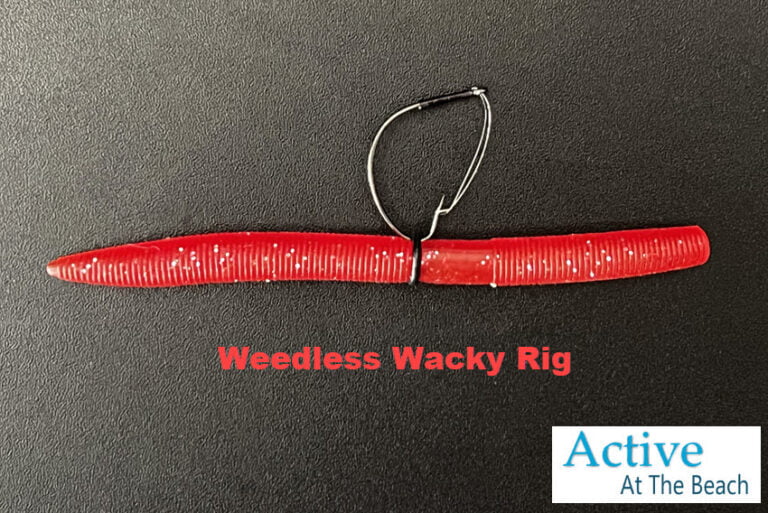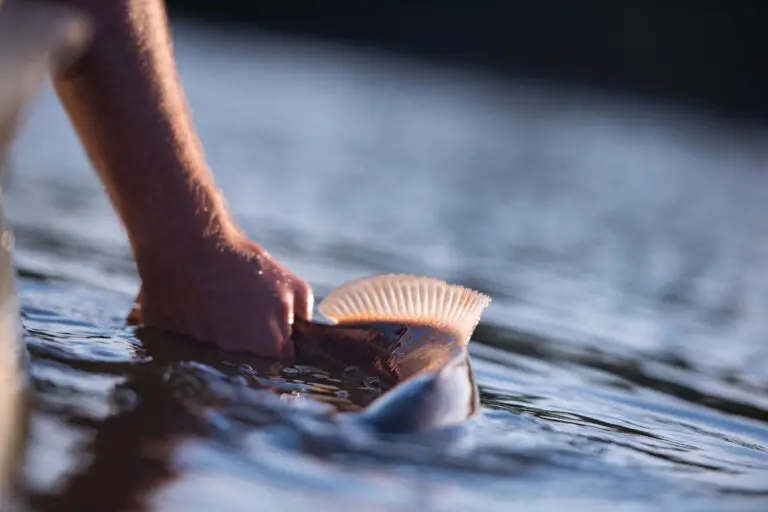Texas Rig: Master How To Rig Setup And Fish With The Best Lures
The Texas rig is a great setup for bass fishing and inshore gamefish like redfish and speckled trout. It’s very versatile and can be used in many different situations. You can use it when fishing in shallow or deep water, clear or murky water, and even at night.
Learn how to build your Texas rig with the best hooks, sinkers, lines, lures, and presentation techniques for inshore and bass fishing.
And don’t miss the videos. I have included the best knots and how to Texas Rig your plastic worms!
Once we get through all of this information together, your fishing trips will be much more successful than they were before!
Let’s start by learning about how the Texas rig works.
What Is A Texas Rig?
The Texas Rig is a simple weedless bait for fishing heavy cover or open water. It is an easy-to-use bait presentation with a soft plastic bait that can move close to the bottom.
The ideal situation for this rig is when you need a weedless, natural-looking bait worked slowly. This setup is perfect for any freshwater or inshore saltwater game fish swimming in open waters, like bass, redfish, and trout.
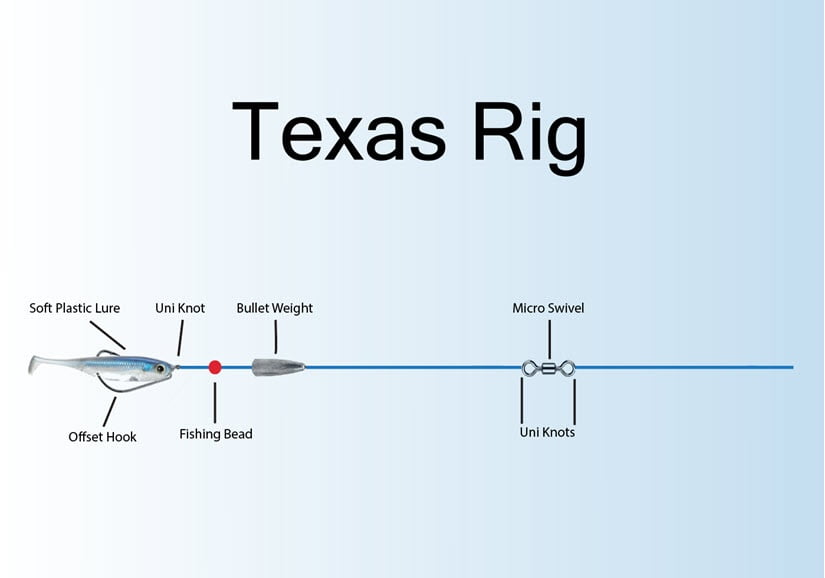
Mastered The Texas Rig? Try Similar Fishing Rigs for Bass and Red Drum
- If you’ve mastered the Texas Rig and want to expand your rig-building skills, consider building out the fish finder rig.
- With our step-by-step guide, learn how to tie a Carolina Rig, one of the best bottom rigs for targeting bass.
- If you’re looking to target bass with a rig that offers a tantalizing floating action, the Senko Wacky Rig is a great option. Here’s a step-by-step guide for tying the Senko Wacky Rig and preparing it for your next bass fishing trip.
- And for targeting red drum, the Carolina Rig can be a particularly effective choice.
Saltwater Fishing Regulations: Rules Beyond Texas and Florida
Regarding saltwater fishing regulations, it’s not just Texas and Florida that have their own rules. Other states like Alabama, Virginia, and Louisiana also have specific regulations to keep in mind, such as Alabama’s saltwater fish species regulations, Virginia’s fishing regulations, and Louisiana’s saltwater fish limits.
Overview Of The Texas Rig Setup
Sinkers determine the water column depth you want to target and the rate at which the worms sink. Different sizes depend on the depth you want to fish.
There are three different weight variations to fish at different points of the water column:
- Lightest weight: when the target fish feed near the surface, also known as a weightless Texas rigging.
- Medium Weight: for shallow water and presenting a lure that falls slowly.
- Heavier weight: usually for heavy cover or very deep water fishing. Used to get your bait down fast and deeper in waters about 20 feet deep.
The typical Texas rig consists of:
- 8 to 12-pound braided or fluorocarbon main line
- Micro swivel attached to the main line to prevent line twist
- 4-Foot monofilament leader attached to the other side of the micro swivel
- Bullet-shaped sinker
- Fishing bead
- Offset hook
- Soft plastic lure
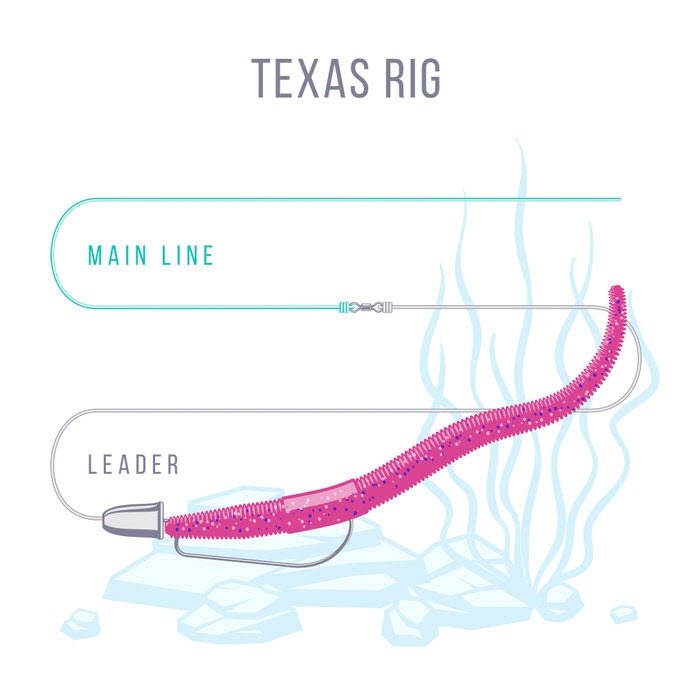
How To Set Up A Texas Rig
- To start, tie the braided mainline to a micro-swivel using a uni knot. The swivel will prevent line twists when retrieving.
- Tie the fluorocarbon leader line to the other end of the micro-swivel with another uni knot.
- Slide the bullet weight through the leader line.
- Slide a fishing bead on the leader.
- Tie the hook to the end with a uni knot.
- Bait the hook with a soft plastic lure.
Choosing The Right Texas Rig Weight
There are quite a few types of weights used for this setup. The most common include:
- bullet weights
- egg-shaped weights
- split shot
- jig heads
I use a bullet weight for Texas rigs and most worm rigs in general. They slide on the line before you tie the hook and sit at the front end of the worm.
- Lightest weight rig: 1/4-oz
- Medium-weight rig: 3/8-oz
- Heavier weight rig: 1/2-oz to 1 oz
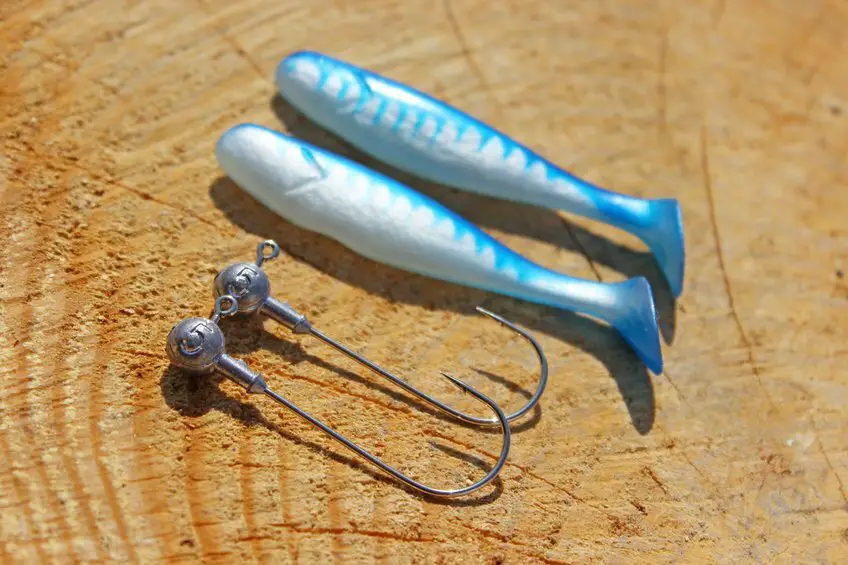
Pegging The Sinker
Some people like to peg their lines for an enticing presentation. Pegging involves attaching your bait to a line at the bottom of the water column allowing it to dangle in front of the fish.
Pegging with weight right under the nose of the lure will put the worm at the bottom. Using weighted hooks is another method to peg the sinker.
Fishing Line Choices For The Texas Rig
When constructing your fishing rig, one of the most critical decisions you’ll make is choosing the right fishing line. The water conditions and cover influence the type of line used in this presentation.
Main Line
- 30 – 50 lbs test: inshore saltwater fishing
- 12 – 20 lbs test: freshwater fishing
- Braided line: best for murky water or dense vegetation with non-stretch, lowering the danger of a fish breaking off.
- Fluorocarbon line: best for clear water or high visibility conditions.
Leader Line
- 30 – 50 lbs test: inshore saltwater fishing
- 12 – 20 lbs test: freshwater fishing
- Fluorocarbon line: best for clear water or high visibility conditions, middle to heavyweight rigs. Denser and sinks well.
- Monofilament line: best for murkier water, lightweight, and weightless rigs. More visible leader material with stretch.
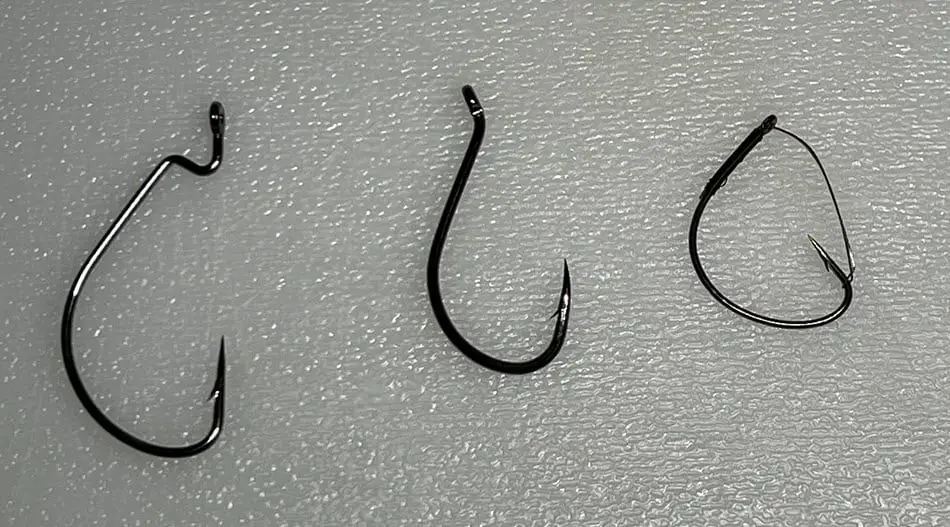
Choosing The Texas Rig Hook
The hooks you need to use depends upon the size of the baits. You measure from the hook eye, along the hook shank, to the hook’s point.
Here are the popular hook sizes:
- 2/0: for small soft plastic baits like creature baits or crawfish
- 4/0: 6″ to 8″ soft plastic baits
- 6/0 or 8/0 if you are fishing with a 10-inch magnum-sized worm

Typical hook types are:
- Straight shank hook. This style is perfect when flipping and pitching in thick cover where protecting your bait from snags is a priority. Beware, it can allow plastic baits to slide down the shank due to a lack of an offset or bend. Ensure to choose one with added shank barbs or add a bobber stop to keep baits in place.
- Offset round bend hook. In all situations, this hook is a smart option. The eye of the hook has a “Z” bend behind it. This can assist in keeping bait and soft plastics on the hook.
- Offset extra-wide gap or EWG hook. Use an offset worm hook for thicker plastics in all circumstances. It will allow for better hook access when using this size of lure.
- Circle hook. The perfect choice for the Texas rig. Circle hooks are designed to catch fish in the corner of their jaw, causing less damage than other types.
The Only Two Knots You Will Need To Construct The Texas Rig
The Uni Knot
Watch the video on the Fishatwontquit channel to learn how to tie the uni knot. The video explains the knot building so simply that it will be easy to understand even for beginners.
When you set the hook, drive the point into the bait and the lure to ensure it penetrates thoroughly. A Texas-rigged soft-plastic bait has a hook point in the middle of the lure, so you must pull point through the bait and into the fish’s mouth.
The Palomar Knot
The Palomar Knot is excellent for all Texas Rig purposes, and it’s best for those who fish with big eye hooks, such as an offset or octopus circle.
To see how to tie the Palomar knot, watch the Fishatwontquit channel video. Even if you’re a novice, the video makes learning this knot easily.
How To Hook A Texas Rigged Lure
The uni knot can be used in various ways and has many benefits. It is the best knot for tying a swivel and hook in a line. Learning is straightforward and does not take much time to do it correctly.
To Hook A Lure:
- Insert the barb point into the nose of your worm, lizard, creature, or crawfish and push it about a 1/2 inch into the bait, then exit the body
- Slide the body over the eye of the hook, turn the hook 180 degrees, and re-insert the point.
- Push it through the hook shaft, then back it off so that the hook point lies just beneath the surface of your bait.
I sometimes find it better to learn techniques like this one, so I included this easy-to-follow video from the Ultimate Fishing Site channel on how to do it.
Typical Texas Rig Lures
The vast selection of soft plastic baits makes Texas Rigs highly customizable.
You can find every kind of soft plastic lure on the shelves of any fishing tackle shop. These lures mimic anything from crawfish to frogs.
Soft plastic lures and creatures you can use for this setup are:
- ribbon tail, straight tail worms, paddle tail worms, and curly tail worms
- shad tails
- crawfish, crayfish, and craw-bugs
- crawdads
- lizards and toads
- creatures
- beavers
- tubes
- stick baits
- trailers
- jerk baits
- beetles
- drop-shot baits
Let’s go over the most common bait that I use.

Plastic Worms And Other Soft Plastics
Plastic worms are the most popular bait to be used in Texas rigs.
A light plastic stick bait with a little 1/4-ounce weight is subtle enough to elicit bites in the colder months. You can revert to ribbon tails and ringworms when the water becomes warmer.
Plastic ribbon tail worms come in sizes up to 12 inches long and are more attractive bait for big bass.
Plastic Crawfish
Soft plastic crawfish or animal baits, designed to resemble the bass’s preferred food, mimic the creature’s size and profile.
The tiny crawfish and creature bait can be fished on a wide range of sinkers, from 1/8-ounce for a sluggish fall at colder temperatures to larger 2-ounce sinkers. My favorite colors are watermelon and Green Pumpkin, black, and blue. Feel free to experiment with other hues.
Where Can I Fish A Texas Rig?
There are several most suitable locations for fishing rigged Texas style, but the most reliable place is on points with steep drop-offs. The Texas rig is also ideal for dense vegetation and heavily deforested waters.
Seek out a bank with catch covering and cast well over the possible hiding spots. Let the rig settle to the bottom and glide or rake the worm through the area back to the boat or bank.
Texas Rig Fishing In Cold Weather
In most locations, finding bass feeding around submerged weeds and cover when the water is colder throughout the winter is difficult. You may fish for hours without getting any bites!
Sometimes the best chance of catching the fish in these conditions is to fish close to the top in open water. Deep, colder water fish are sluggish and pickier when biting or chasing your bait. As a result, most bass anglers prefer to operate at shallower depths during the winter months.
Shake the rod gently to present the worm or creature. This action generates an appealing motion in your bait and may occasionally attract a fish.
Texas Rig Fishing In Warm Or Hot Weather
The hot summer months are when Texas rigging is most successful. When the weather is peaceful and sunny, cast your bait into weed mats using Texas rigs to entice bass out of hiding.
Flipping and pitching are effective methods to catch bass when the water is calm. Flipping or pitching a Texas rig in hot weather allows you to show your bait so that it comes through the grass with little resistance, which can induce strikes from bass hiding below.
Flipping A Texas Rig In Heavy Weeds
You’ll need heavier bullet weights to penetrate through the long thick tops of summer weeds.
Using hefty setups, your bait can break through the top of the weed beds and into the fish strike zone. The heavier mats can require a 1 1/4-ounce weight or more.
Presenting The Texas Rig
The secret to presenting a Texas-rigged worm is hiding the hook within the plastic, and this tactic is comparable to an inverted Carolina rig.
When beginning, keep the presentations simple using one of these three methods:
- Drag or Crawl Presentation
- Swimming Presentation
- Lift and Drop Presentation
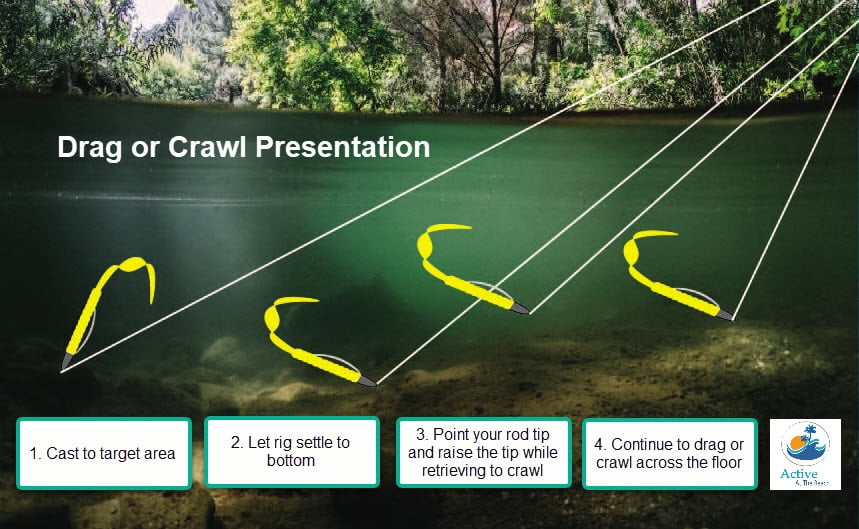
Drag Or Crawl Retrieval Presentation
You can use a crawl or drag retrieval in all water and cover situations. Cast the bait and allow it to settle to the bottom.
Point your rod tip at the bait and take up line slack with the reel. Slowly raise the tip of the rod so the bait will crawl across the floor.
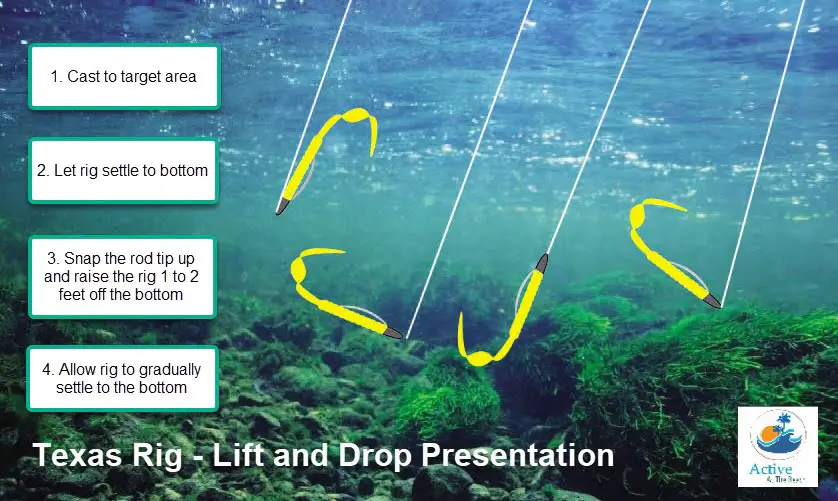
Lift And Drop Presentation
The lift-and-drop method, which involves lifting the bait out of the water and dropping it back in, is successful in areas without shelter.
The goal of the lift and drop is for the bait to rise off the bottom one or two feet and fall back down. This is accomplished by casting the bait and allowing it to settle to the bottom, then raising the rod gradually for the bait to sink.
Raise the rod immediately so the bait moves up in the water column with a snap from eight or nine to eleven. Repeat until there is no more line on offer, then repeat.
Swimming Presentation
Cast the bait beyond most bass-holding areas and reel it back steadily and naturally. This tactic requires trial and error to determine the optimum lure speed appealing to the bass.
Change speeds to allow the bait to swim from just off the bottom to a few inches below the surface.
If the bites slow down or stop, change the retrieve speed to find the new aggression level of the bass. This aggression level can vary throughout the day depending on the conditions.
Conclusion
The Texas Rig is a time-testing fishing technique for bass fishing. Also, it’s a beautiful choice for saltwater redfish and speckled trout anglers.
You were given a comprehensive guide for:
- An overview of how the Texas rig setup works
- How to build your own Texas rig
- The best hooks, sinkers, and lines for this setup
- Popular soft plastic worms and creatures you can use for this setup
- How to rig the bait Texas-style
- How to fish a Texas rig
- Where to fish with the Texas rig
- Three best presentations


